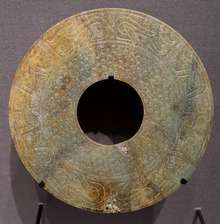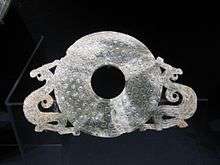Bi (jade)
| Bi | |||||||||
_%E7%92%A7_disc.jpg) A Han-era bi, 16 cm in diameter. | |||||||||
| Chinese | 璧 | ||||||||
|---|---|---|---|---|---|---|---|---|---|
| |||||||||

The bi is a type of circular ancient Chinese jade artifact. The earliest bi were produced in the Neolithic period, particularly by the Liangzhu culture (3400–2250 BCE).[1] Later examples date mainly from the Shang, Zhou and Han dynasties. They were also made in glass.
Description
A bi is a flat jade disc with a circular hole in the centre. Neolithic bi are undecorated, while those of later periods of China, like the Zhou dynasty, bear increasingly ornate surface carving (particularly in a hexagonal pattern) whose motifs represented deities associated with the sky (four directions) as well as standing for qualities and powers the wearer wanted to invoke or embody.
As laboriously crafted objects, they testify to the concentration of power and resources in the hands of a small elite.[1]
Meaning
Later traditions associate the bi with heaven, and the cong with the earth. Bi disks are consistently found with heaven and earth-like imagery, suggesting that the disk's circular shape also bears symbolic significance as this description explains:
It is found that these objects testify to early stages of development of cosmological concepts that remained important in Chinese culture during the Warring States and Han periods: the notion of a covering sky (gaitian) that revolves around a central axis, the cycle of the Ten Suns, and the use of an early form of the carpenter's square. These objects were handled by shamans who were the religious leaders of Liangzhu society and the transmitters of cosmological knowledge.[2]
Function

The original function and significance of the bi are unknown, as the Neolithic cultures have left no written history. From these earliest times they were buried with the dead, as a sky symbol, accompanying the dead into the after world or "sky", with the cong which connected the body with the earth.[1] They were placed ceremonially on the body in the grave of persons of high social status. Bi are sometimes found near the stomach and chest in neolithic burials.[1]
Jade, like bi disks, has been used throughout Chinese history to indicate an individual of moral quality, and has also served as an important symbol of rank. They were used in worship and ceremony – as ceremonial items they symbolised the ranks of emperor, king, duke, marquis, viscount, and baron with four different Guis and two different bi disks.
In war during the Zhou dynasty period (c. 1046–256 BCE), bi disks belonging to the leaders of the defeated forces were handed over to the victor as a sign of submission.
Influences
The design of the reverse side of the medals given in the 2008 Summer Olympics in Beijing, China are based on bi disks.[3]
See also
References
- 1 2 3 4 Teaching Chinese Archaeology, object 3 - NGA Archived May 8, 2008, at the Wayback Machine.
- ↑ Shu-P'Ing, Teng (2000). "The Original Significance of Bi Disks: Insights Based on Liangzhu Jade Bi with Incised Symbolic Motifs". Journal of East Asian Archaeology. 2 (1): 165–194. doi:10.1163/156852300509835.
- ↑ Design of the Medal for the Beijing 2008 Olympic Games Archived August 12, 2008, at the Wayback Machine.
External links
| Wikimedia Commons has media related to Bi. |
| Look up bi in Wiktionary, the free dictionary. |
- "A History of the World - Object: Ancient Jade Bi, around 3,000 years-old, inscribed with a poem by its later owner, the Chinese Qianlong Emperor". BBC and British Museum. 22 September 2008. Retrieved 17 June 2010.
- Video—National Geographic, Smithsonian's Freer and Sackler Galleries, Washington, D.C.; September 7, 2013